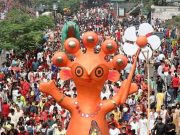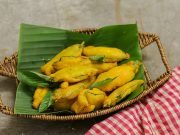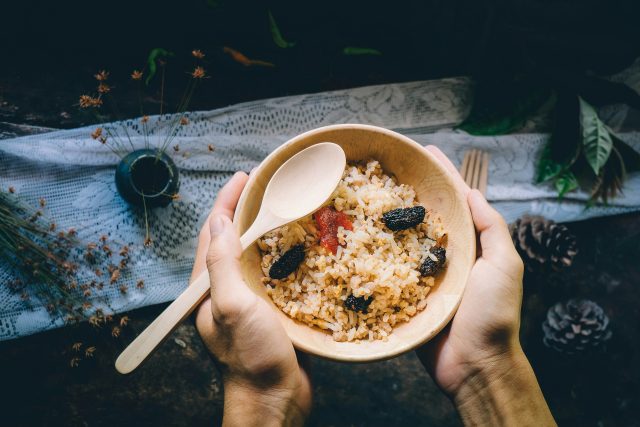Thousands of miles from where the 2,000-year-old grain bowl called lei cha, or “thunder tea rice”, was first created in China, Hakka chef Pang Kok Keong has reworked the ancient delicacy in his Singapore kitchen for a new generation of healthy eaters.
Thunder tea rice – a bowl of rice topped with a balance of vegetables, peanuts, dried fish, and more, served with a bold-flavored green “tea soup” – is the specialty of the Hakka people in Guangdong Province. Of which there are many groups, the Hakka originally came from China’s Central Plains. Over many centuries of war, they migrated in many directions. They migrated southwards in the 4th Century to avoid famine and war, coming to settle down in these mountains. Here, they gained a new name among the inhabitants.
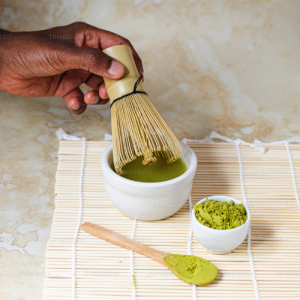
“[They were] called Kejia Ren because they do not have a province of their own,” says anthropologist Dr Vivienne Wee. Centuries later, the Hakka journeyed further to countries such as Taiwan, Singapore, Malaysia, and Indonesia, taking their recipes with them, including thunder tea rice.
The former award-winning French pastry chef and owner of Antoinette, one of Singapore’s most well-known patisseries, which is now closed, used to make a living piping chocolate into macaron shells or calmly checking orders of violet mousse cakes garnished with black sugar. But as he approached 40, he began to contemplate his heritage more. He noticed that few and far between were Hakka food outlets in Singapore. He wanted to go back to his roots and make the herby green thunder tea rice, among other dishes he ate as a child. He scoured the internet for inspiration, buying books on Hakka culture and perfecting heritage flavors with his mother’s help. “She didn’t have anything written down,” Pang says. “I’d test something, letting her try it.”.
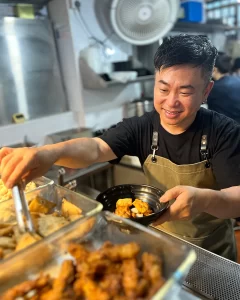 Most of the chefs that Pang worked with were of Hakka descent is the fourth largest Chinese dialect group in Singapore-but had never tried Hakka food. When Pang mentioned that he wanted to open a hawker stall, his team rose to the challenge. Pang knew this was the moment. “Being a chef, you sort of have this superpower to create. With the knowledge that I have and with the research I had done, I thought I could do my part,” Pang says.
Most of the chefs that Pang worked with were of Hakka descent is the fourth largest Chinese dialect group in Singapore-but had never tried Hakka food. When Pang mentioned that he wanted to open a hawker stall, his team rose to the challenge. Pang knew this was the moment. “Being a chef, you sort of have this superpower to create. With the knowledge that I have and with the research I had done, I thought I could do my part,” Pang says.
In 2018, he opened Pang’s Hakka Delicacies, one of two street food kitchens he runs today in Singapore. The standout on the menu is a thunder tea rice made to his recipe. The legend goes that this dish was concocted during the war of the Three Kingdoms between 220 CE and 280 CE, where General Zhang Fei’s soldiers developed a mysterious plague before the battle. A doctor prepared and prescribed thunder tea rice with much success, boosting their strength and immunity levels. Today, the power-packed dish capitalizes on a growing interest in healthy rice bowls. Singaporean nutritionist Charlotte Mei explains that thunder tea rice is especially nourishing. “Grain bowls have this healthy halo around them, however, they don’t contain a lot of leafy vegetables. What we have with the thunder tea rice is these dark green leafy vegetables that are nutritious. They’re high in antioxidants and in some cases iron and calcium.”
Pang tries to make the dish as authentically as possible. “For me, it has always been to preserve the taste of Hakka food as I remember it,” he says. The only modern shortcut that he takes is trading in the pestle and mortar for a blender so that he can churn out dishes for hungry customers in rapid succession.
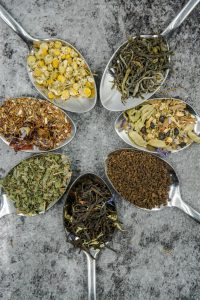
Ingredients:
For the tea paste:
140g Thai basil leaves ,60g mint leaves , 30-60g mugwort leaves (depending on how intense you like the bitter taste) ,30g Chinese coriander stems and leaves,60g roasted peanuts,40g roasted sesame seeds ,8g oolong tea leaves (optional) ,700ml ice water, Salt to taste .
For the toppings:
Choose at least five different toppings. Make sure each topping can easily be scooped up with a spoon. 15-20g Hong Kong kailan, chopped 15-20g long beans, diced 15-20g wing beans, sliced 15-20g cabbage, sliced 15-20g preserved turnips preserved in salt, 7g ikan bilis , 10-15g peanuts, fried and peeled , 15-20g deep-fried tofu, cut into small cubes , Vegetable oil for frying , A pinch of salt
To serve: 150g brown rice or white rice per serving Water for boiling
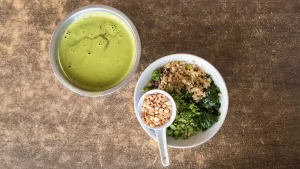 Method
Method
Step 1 :Make the tea paste: Blanch the herbs in boiling water and shock in a bowl of ice water. Strain and squeeze dry. Roughly chop the herbs so they’re easier to blend. Add the herbs and remaining ingredients to a blender and blend until smooth; season with salt.
Step 2 : Prepare the toppings: Heat some oil in a wok. Stir-fry the kalian, long beans, wing beans, and cabbage briefly under high heat and add some water so they are cooked evenly. It may splatter a little. Season with salt. Remove from the wok and set aside. Saute the salted preserved turnips in some oil until fragrant. Deep fry the ikan bilis till crispy.
Step 3 : Place each serving of tea paste into individual bowls of 150-200g. Freeze extra in resealable plastic bags. Fill deep soup bowls with hot rice. Next, top rice with your choice of toppings.
Step 4 : Pour boiling water over the tea paste into the bowls. The amount of water to your liking depends on how strong you like the soup. It is to be eaten as it is or the soup is to be poured over the rice.





